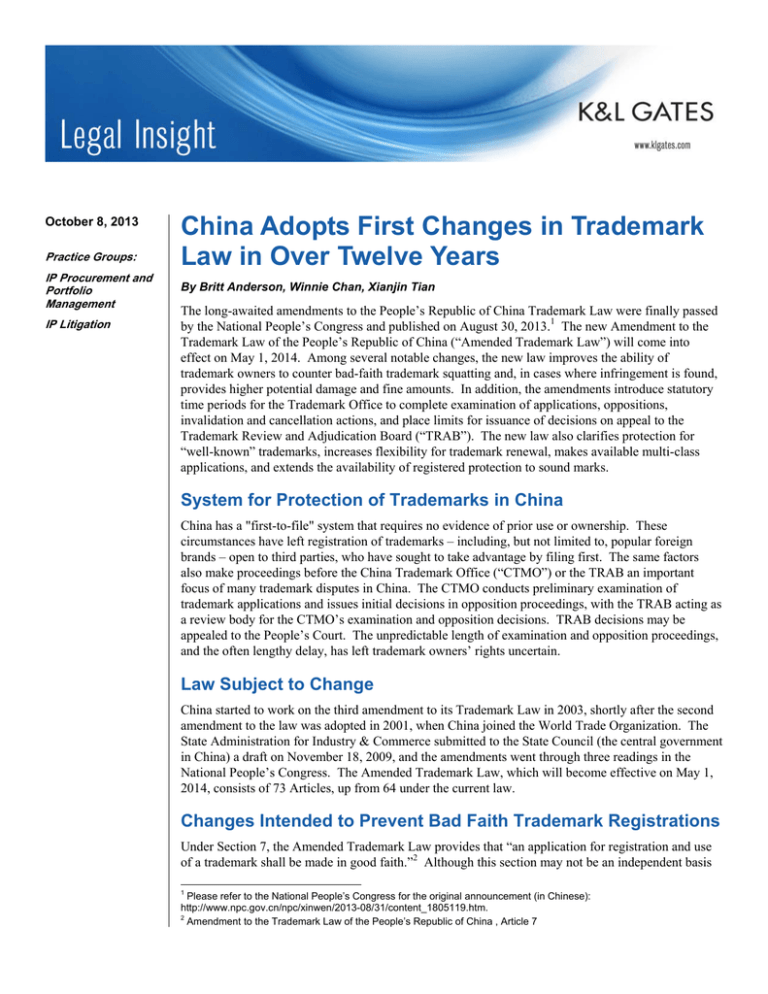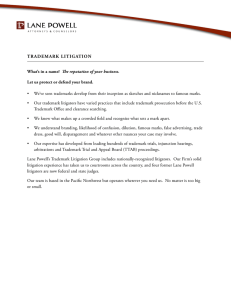
October 8, 2013
Practice Groups:
IP Procurement and
Portfolio
Management
IP Litigation
China Adopts First Changes in Trademark
Law in Over Twelve Years
By Britt Anderson, Winnie Chan, Xianjin Tian
The long-awaited amendments to the People’s Republic of China Trademark Law were finally passed
by the National People’s Congress and published on August 30, 2013.1 The new Amendment to the
Trademark Law of the People’s Republic of China (“Amended Trademark Law”) will come into
effect on May 1, 2014. Among several notable changes, the new law improves the ability of
trademark owners to counter bad-faith trademark squatting and, in cases where infringement is found,
provides higher potential damage and fine amounts. In addition, the amendments introduce statutory
time periods for the Trademark Office to complete examination of applications, oppositions,
invalidation and cancellation actions, and place limits for issuance of decisions on appeal to the
Trademark Review and Adjudication Board (“TRAB”). The new law also clarifies protection for
“well-known” trademarks, increases flexibility for trademark renewal, makes available multi-class
applications, and extends the availability of registered protection to sound marks.
System for Protection of Trademarks in China
China has a "first-to-file" system that requires no evidence of prior use or ownership. These
circumstances have left registration of trademarks – including, but not limited to, popular foreign
brands – open to third parties, who have sought to take advantage by filing first. The same factors
also make proceedings before the China Trademark Office (“CTMO”) or the TRAB an important
focus of many trademark disputes in China. The CTMO conducts preliminary examination of
trademark applications and issues initial decisions in opposition proceedings, with the TRAB acting as
a review body for the CTMO’s examination and opposition decisions. TRAB decisions may be
appealed to the People’s Court. The unpredictable length of examination and opposition proceedings,
and the often lengthy delay, has left trademark owners’ rights uncertain.
Law Subject to Change
China started to work on the third amendment to its Trademark Law in 2003, shortly after the second
amendment to the law was adopted in 2001, when China joined the World Trade Organization. The
State Administration for Industry & Commerce submitted to the State Council (the central government
in China) a draft on November 18, 2009, and the amendments went through three readings in the
National People’s Congress. The Amended Trademark Law, which will become effective on May 1,
2014, consists of 73 Articles, up from 64 under the current law.
Changes Intended to Prevent Bad Faith Trademark Registrations
Under Section 7, the Amended Trademark Law provides that “an application for registration and use
of a trademark shall be made in good faith.”2 Although this section may not be an independent basis
1
Please refer to the National People’s Congress for the original announcement (in Chinese):
http://www.npc.gov.cn/npc/xinwen/2013-08/31/content_1805119.htm.
2
Amendment to the Trademark Law of the People’s Republic of China , Article 7
China Adopts First Changes in Trademark Law in Over
Twelve Years
for a decision by the CTMO in an opposition case, the new law introduces the requirement of good
faith for trademark applications in important areas, including cases of pre-existing contractual
relationships, behavior of trademark agencies, enhanced damages, and other areas.3 These changes
may deter bad faith filings, or may at least give trademark owners grounds for opposing applications
that have been made in bad faith.
Provision of Rights against Business Contacts, Manufacturers
and Distributors
The new law states that “[w]here a trademark applied for registration is identical with or similar to
another person’s prior used but yet unregistered trademark, in respect of same or similar goods, and
the applicant has contractual or business contacts, or other relations…, with the prior trademark user
so that the applicant definitely knows the existence of this person’s trademark, if this person files
opposition, the applied trademark shall not be registered.”4 This new provision should help protect
trademark owners against business contacts, manufacturers, and distributors who may apply to register
the owner’s trademarks in China.
Introduction of Time Period Limits for Action by CTMO and
TRAB
The new law imposes time limits for examination and review by the CTMO and the TRAB, so that
decisions on trademark applications, oppositions, invalidations and cancellation actions are issued
more quickly.5 These changes should provide trademark owners quicker solutions and more certainty
on the timeframe for these procedures. Some of these new time limits are set out in the table below.
Procedure
Time limit
Extension
Preliminary approval or rejection of a trademark
application (CTMO)
9 months
No extension
Review of CTMO’s rejection decision (TRAB)
9 months
3 months
Decision on opposition (CTMO)
12 months
6 months
Review of CTMO’s opposition decision (TRAB)
12 months
6 months
Invalidation of a registered trademark based on
absolute grounds (TRAB)
9 months
3 months
Invalidation of a registered trademark based on
relative grounds (TRAB)
12 months
6 months
Cancellation of a registered trademark based on nonuse (CTMO)
9 months
3 months
Review of CTMO’s cancellation decision (TRAB)
9 months
3 months
3
See, e.g., Articles 15.2, 19, 45, and 63.
Article 15.2.
5
See Articles 34, 35, 44, 49, and 54.
4
2
China Adopts First Changes in Trademark Law in Over
Twelve Years
Reduced Burden of Proof of Damages with Higher Available
Amounts
In infringement actions, the new law is expected to make it easier for plaintiffs to show the quantity of
infringing products sold, thereby assisting proof of damages available to a plaintiff.
Specifically, the Amended Trademark Law provides, “[w]here the plaintiff has fulfilled its burden of
proof in facilitating the court in determining the amount of compensation, while the account books
and any other materials as connected with the infringing act were mostly in the control of the
infringer, the court may order the infringer to provide such account books and materials. If the
infringer refuses to provide such information or provide false information, the People’s Court may
determine the amount of compensation at its discretion by taking into account the claims of the
plaintiff.”6
Statutory damages have also been increased under the new law for trademark infringement cases.
Current law provides that available damages shall consist of the infringer’s profits, the amount of the
trademark right holder’s lost profits, or a license fee. These damage categories continue to be
available, but under the Amended Trademark Law, where “the infringement on the exclusive right to
use a trademark is committed maliciously and involves serious infringement,” damages awarded may
be not less than one time and up to three times the amount of the infringer’s profits, the trademark
right holder’s loss, or the license fee.7 Damages will also include reasonable expenses incurred by the
owner of a trademark in stopping the infringement.8 Furthermore, the new law provides that if the
amount of the actual loss, illegal gain, or license fee is difficult to determine, the court may award
damages with the maximum amount of 3 million RMB (around US$500,000).9
These enhanced damages provisions are likely to encourage trademark plaintiffs to take civil court
procedures against infringers.
Other Notable Changes
Change of Pre-Registration Opposition Procedure
The Amended Trademark Law provides two important modifications of opposition procedures that
may affect trademark owners’ ability to block infringing applications. First, under current law, any
party may raise opposition against a published application, but under the new law, only “a prior right
owner or interested party” may raise an opposition based on relative grounds – e.g., likelihood of
confusion – while any party may raise an opposition based on absolute grounds, such as
descriptiveness.10
Second, under the new law, if an opposition is rejected by CTMO, the trademark is immediately
approved for registration.11 Under such case, the opposer will now be required to file a postregistration invalidation action with TRAB against the trademark. In contrast, under current law, if a
prior right owner’s opposition is rejected by the CTMO, the prior right owner can file a review with
the TRAB, without the opposed application registering, potentially receiving a reversal of the
6
Article 63.2.
Article 63.
8
Id.
9
Id.
10
Amended Trademark Law, Article 33.
11
Amended Trademark Law, Article 35.2.
7
3
China Adopts First Changes in Trademark Law in Over
Twelve Years
CTMO’s decision. This change is expected to prevent filing of bad faith oppositions, although it may
in some cases make it more difficult to stop parties from initiating use of infringing trademarks.
Protection for Prior User within Previous Range
In language providing an interesting exception to the principle of “first to file” a trademark
application, the new law provides: “Where, prior to the application date for a registered trademark, a
person has been using a trademark identical with or similar to such registered trademark in respect of
the same or similar goods, and such use has started before the registrant of the registered trademark,
and has acquired a certain influence, the holder of the registered trademark has no right to prohibit
such person from continuing using his trademark within its previous usage range.”12
While bad faith can also be used as a basis to oppose an application or to cancel a registration, in a
case where such procedures are not successful or available, this provision appears to provide prior
users with a basis to continue to use the trademark within its previous usage range without
interference by the owner of a trademark registration.
No Damages Available to an Owner of a Trademark that Is Not in Use
Under the Amended Trademark Law, if the registered trademark owner cannot prove the use of the
trademark within the prior three years or other losses in an infringement case, the infringer shall not be
held liable for damages.13 This requirement for use in the case of a damages claim does not appear to
affect the ability of the owner to cause the infringement to cease, although a trademark not used for a
three-year period may still be subject to a separate cancellation action.
“Well-known” Trademark Status
Under the Amended Trademark Law, no party is allowed to use the “well-known” trademark
expression in the commodities, the commodity packages, the containers, or in advertisement,
exhibition, or other commercial activities.14
In practice, primarily Chinese companies use such an expression when they obtain “well-known”
status. In fact, the availability of this expression has been a significant incentive for some Chinese
companies to obtain the “well-known” status. With this amendment, regulators want to restrict the
status to legal procedures in trademark cases. At this time, it is not clear whether this change will
increase chances for foreign owners to obtain a “well-known” trademark status in China.
Implementing Regulations
The State Council will issue revised “Implementing Regulations” based on the Amended Trademark
Law, which may further clarify certain issues.
12
Amended Trademark Law, Article 59.3 (emphasis added).
Article 64.
14
Article 14.
13
4
China Adopts First Changes in Trademark Law in Over
Twelve Years
Authors:
Britt L. Anderson
britt.anderson@klgates.com
+1.650.798.6746
Xianjin Tian
xianjin.tian@klgates.com
+1.86.10.5817.6103
Winnie W.N. Chan
winnie.chan@klgates.com
+1.852.2230.3503
Anchorage Austin Beijing Berlin Boston Brisbane Brussels Charleston Charlotte Chicago Dallas Doha Dubai Fort Worth Frankfurt
Harrisburg Hong Kong Houston London Los Angeles Melbourne Miami Milan Moscow Newark New York Orange County Palo Alto Paris
Perth Pittsburgh Portland Raleigh Research Triangle Park San Diego San Francisco São Paulo Seattle Seoul Shanghai Singapore Spokane
Sydney Taipei Tokyo Warsaw Washington, D.C. Wilmington
K&L Gates practices out of 48 fully integrated offices located in the United States, Asia, Australia, Europe, the
Middle East and South America and represents leading global corporations, growth and middle-market companies,
capital markets participants and entrepreneurs in every major industry group as well as public sector entities,
educational institutions, philanthropic organizations and individuals. For more information about K&L Gates or its
locations, practices and registrations, visit www.klgates.com.
This publication is for informational purposes and does not contain or convey legal advice. The information herein should not be used or relied upon in
regard to any particular facts or circumstances without first consulting a lawyer.
©2013 K&L Gates LLP. All Rights Reserved.
5


